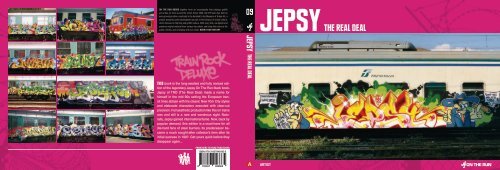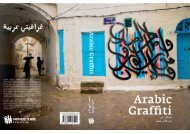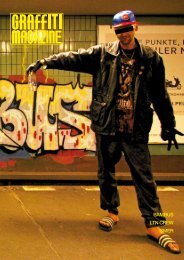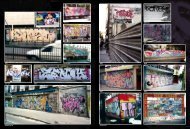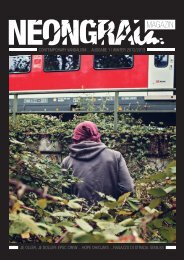You also want an ePaper? Increase the reach of your titles
YUMPU automatically turns print PDFs into web optimized ePapers that Google loves.
ON THE RUN BOOKS together form an encyclopedia that catalogs graffiti<br />
and urban art from around the world. Since 1990, the OTR team has built an<br />
ever-growing archive, eventually to be donated to the Museum of Urban Art, a<br />
project presently under development as part of the Campus of Urban Culture,<br />
which focuses on Hip Hop and graffiti culture. With every title, we digitize and<br />
preserve original material from various key artists, and bring their story to the<br />
public. All this, and in keeping with our motto: KNOW YOUR HISTORY.<br />
09<br />
JEPSY THE REAL DEAL<br />
JEPSY THE REAL DEAL<br />
This book is the long-awaited and fully revised edition<br />
of the legendary Jepsy On The Run black book.<br />
Jepsy of TRD (The Real Deal) made a name for<br />
himself in the mid 90s setting the European transit<br />
lines ablaze with his classic New York City styles<br />
and elaborate characters executed with clear-cut<br />
precision. Full aesthetic production like this on trains<br />
was and still is a rare and wondrous sight. Naturally,<br />
Jepsy gained international fame. Now, back by<br />
popular demand, this edition is a must-have for all<br />
die-hard fans of steel burners. Its predecessor became<br />
a much sought-after collector’s item after its<br />
initial success in 1997. Get yours quick before they<br />
disappear again...<br />
FROM HERE TO FAME PUBLISHING<br />
A<br />
124 125<br />
ARTIST
INTRODUCTION<br />
“<br />
‘OTR Blackbook Vol.1 – Jepsy’ really had a great impact around<br />
the world. It delivered what people expected after the first On The<br />
Run magazines blew their minds. Those were the times before<br />
the Internet and when graffiti books weren’t published on<br />
a weekly basis. This one was a real must-have for every<br />
writer’s bookshelf. Wherever I went traveling, it was<br />
already there... ” Stone<br />
In the last ten years, since the original ‘OTR<br />
Blackbook Vol.1 – Jepsy’ sold out, it has become<br />
a much sought-after collector’s item; at times<br />
changing hands for triple-digit prices for those<br />
lucky enough to still find one of these rare gems<br />
online or elsewhere. Even today we are inundated<br />
with requests from all over the world asking for<br />
this book. This demand, combined with our own<br />
fancy, prompted the decision to keep the Jepsy<br />
legacy alive with a completely revamped new edition.<br />
‘Jepsy – The Real Deal’ revisited and revised,<br />
is both a tribute to the artist and to the humble<br />
beginnings of the On The Run book series.<br />
left page: JEPSY / Mainz / 1997<br />
ZEBSTER: The classic On The Run graffiti<br />
magazine stopped in 1992, and after a sleeping<br />
phase of five years, the first On The Run black<br />
book came out in 1997—Jepsy. At the time Jepsy<br />
pieces were really advanced: classic semi-wild<br />
style panels with European color schemes and<br />
crisp outlines. He definitely owned a place in the<br />
German graffiti hall of fame and therefore was a<br />
suitable candidate for an OTR book. While other<br />
magazines worked on the idea of publishing as<br />
many pictures possible from random writers, we<br />
thought it was time for a change. The concept of<br />
this new OTR series was to concentrate on the<br />
body of work of one writer and present his art in<br />
big photos. The idea for that format came from<br />
Kotthoff aka <strong>To</strong>pic One, who was editor in chief<br />
and layout designer for the MZEE magazine and<br />
also my partner at MZEE at the time. <strong>To</strong>pic took<br />
care of<br />
the whole project<br />
management, artist liaison<br />
and layout. I was already busy on other projects<br />
and was happy for him to take the lead.<br />
The ‘OTR Blackbook Vol.1 – Jepsy’ was the first<br />
publication ever to concentrate ‘only’ on one graffiti<br />
artist. The book became very successful and the<br />
whole print run of 8,000 copies was already sold<br />
out one year later... <strong>To</strong>pic then started work on<br />
the next OTR books. In 1998 he brought out ‘OTR<br />
Blackbook Vol. 2 – Bates’ in the same format, followed<br />
in 1999 by ‘OTR Blackbook Vol. 3 – Seen’,<br />
(which by then already had 138 pages with gluebinding).<br />
Also those print runs of 8,000 copies each<br />
were sold out within the year.<br />
5
KANDE, JEPSY / Hamburg / 1995<br />
JEPSY: We were really lucky with this whole car. Kande was<br />
the most professional train bomber at this time; he knew all<br />
the time schedules. We didn’t have much time for this car<br />
and as I was putting on the finishing touches Kande grabbed<br />
me and said we had to go. We ran back through the tunnel<br />
to the exit and just as we exited the tunnel we heard a<br />
car coming at high speed. We jumped over a small garden<br />
fence and hid behind some bushes. The car stopped in front<br />
of the emergency exit with the headlights shining towards<br />
the exit. But nobody got out of the car. In about 10 seconds<br />
the car raced away. After this frightening moment we<br />
had a good laugh, imagining the cops going down into the<br />
tunnels, standing there in front of the painted car with dust<br />
rising in the air and the paint still dripping wet, wondering<br />
where the hell we were. In the morning we waited for that<br />
car, but it didn’t pull out. So we decided to ride the track,<br />
watching out for it, but it had disappeared. We checked the<br />
buff and there it was. We could see it standing in the yard,<br />
just about to be buffed. The only chance to get flix was to get<br />
in this restricted area. As Kande and I were still dirty from<br />
the night before, we asked Bloh to enter. Dressed in a knitted<br />
V-neck sweater, he looked like an upright citizen. So he just<br />
walked in, passed the guard, greeted him with a wave while<br />
he pretended to be talking on a mobile phone which was<br />
his beeper and then he took these beautiful shots... lots of<br />
respect for this action!!! Revenge.<br />
“<br />
We had a very tight time schedule for this train and as we were coming to the<br />
end I had to pull Jepsy away from the train because he was too concentrated<br />
on some details... ” KANDE 27<br />
26
Burning STEEL<br />
by STONE<br />
The era of steel train bombing stands today for an<br />
epic time in German writing history. It tells the story<br />
of a lost paradise, when graffiti got its hands on<br />
the trains throughout the country and complete<br />
train systems were taken down on what was beforehand<br />
an unimaginable scale. The trains were<br />
called ‘Silberlinge’ (silver coins) in popular parlance<br />
or ‘Steelers’ and ‘Steelies’ by the writers. They were<br />
first introduced by the Deutsche Bahn in 1959. The<br />
surface of the 86.6 foot-long (26.4 meters) rail cars<br />
was made of polished stainless steel. With 5000<br />
cars in service until 1980, they became the most<br />
commonly used regional and intercity trains for a<br />
long time in Germany.<br />
Because of this vast system, most of the<br />
early writers of the 80s were hardly interested in<br />
left page: GEPSY / Hamburg / 1995<br />
hitting one of these trains. It would have been a<br />
drop in the sea, just one piece never to be seen<br />
again. They had their hands full trying to hit their<br />
local S-Bahn and U-Bahn systems. Beginning of<br />
the 90s, when the development of writing in Germany<br />
further accelerated and the scenes of each<br />
city became more and more interconnected, the<br />
game completely changed. Pieces on steel trains<br />
were added to a writer’s crown jewels and the<br />
yards became a new, popular playground for them.<br />
Main players were the densely populated areas<br />
of the central and northern parts of Germany between<br />
the Rhine-Main area (Frankfurt, Wiesbaden,<br />
Darmstadt, Mainz), the Ruhr District (Dortmund,<br />
Essen, Bochum)<br />
and cities like Hamburg,<br />
Bremen and others.<br />
The silver surfaces of these<br />
trains provided a beautiful canvas perfect<br />
for panels and end-to-ends. Soon enough, writers<br />
found out that their trains were interchanged and<br />
seen in many different cities as well as on their own<br />
home turfs—thus sparking some more organized<br />
efforts to paint. As Menz reports, “Easter 1991 was<br />
probably the first steel train graffiti peak time for<br />
the Rhine-Main area, when we invented an action<br />
called ‘Silbersturm’ [silver storm]. We coordinated<br />
with crews like SCM, TSA [The Stoned Animals]<br />
30 31
and Frankfurt writers with the goal of hitting as<br />
many trains as possible in a concerted timeframe<br />
to keep the steelies bombed.”<br />
By the mid 90s, making a train journey through<br />
Germany had become a writer’s dream; you could<br />
see bombed trains, panels, whole cars and e-toe’s<br />
all over the place. The DB could not keep up<br />
with cleaning anymore and some systems were hit<br />
so hard that writers had to search for untouched<br />
spaces on the trains or go over older, half-buffed<br />
pieces. Some pieces ran for as long as one or even<br />
two years before getting destroyed.<br />
<strong>From</strong> early on, the DB experimented with different<br />
color schemes for the steel trains. This resulted<br />
in the ‘Minties’, which were also popular<br />
among graffiti writers. But by 1996 the DB started<br />
to paint the steel trains red, and as part of a reform<br />
of the railway system they also introduced a “graffitiproof”<br />
coating, which allowed them to clean their<br />
trains with much less effort. Hitting the real steel instead<br />
of those was becoming part of the game. By<br />
the early 2000’s, the steel train era was nearly over<br />
and the writers started to realize what they had lost.<br />
By 2004, the last of these trains’ shiny silver had<br />
been coated by red paint.<br />
JEPSY, KENT / Hamburg / 1995<br />
32 33<br />
“<br />
No matter if it’s his style, colors or characters,<br />
Jepsy mastered it all—hats off brother. ”<br />
KLARK KENT, SUK TNB BSQ / Frankfurt
elow: KITS, BUPS, JEPSY / Hamburg / 1995<br />
JEPSY / on a mint coated steel train / Hamburg / 1995<br />
36<br />
“<br />
His trains were inspirational for many writers. They were motivation and resignation all at once<br />
because the delivered artwork was very hard to top in terms of perfection. HOT, IRA / Germany<br />
”<br />
right page: JEPSY / Hamburg / 1995<br />
37
JEPSY / Dortmund / 1996<br />
Around the end of 1995, some spraycan companies<br />
in Germany adopted the RAL color matching<br />
system and expanded their color ranges. Standardization<br />
saw an overall improvement in paint quality.<br />
Bright colors that had proved weak in the past were<br />
now stronger and more powerful. Plus they came in<br />
an assortment of shades and variations to choose<br />
from. You knew that a RAL 3003 Ruby Red was exactly<br />
that and not just some cheap light red or dirty<br />
red or something else. It made it much easier to<br />
choose the right shades and to mix and match. Like<br />
a kid in a candy store, this new explosion of colors<br />
and the limitless possibilities of color combinations<br />
naturally gave Jepsy renewed motivation to burn<br />
brightly. He explains he was a fiend with the new<br />
color range, like “ooh I have the new RAL 2009 Traffic<br />
Orange and I gotta try it out. Maybe it looks hot<br />
next to this RAL 4010 Telemagenta.”<br />
“<br />
’96 was a good year<br />
because it was just so easy.<br />
We had great new colors, a<br />
good can source, painted<br />
lots, got good photos and<br />
the trains ran for a while. It<br />
gave us the hunger to do<br />
more and more, and have<br />
more cars running all at<br />
once. ” Jepsy<br />
right page: GEPSY / Mainz / 1996<br />
pages 56/57: KEY, SAY, PARK, GEPSY / Mainz / 1996<br />
54 55
“<br />
TRD, Atom (JEPSY) / Mainz / 1996<br />
When I see some of the trains he’s done, his style is<br />
reminiscent of the 1980’s in NYC. His pieces are clean<br />
and legible. Good stuff. ” SYE, TC5 / NYC<br />
right page: JEPSY / Mainz / 1996<br />
84
ATOM, JEPSY / Mainz / 2000<br />
“<br />
Jepsy... that name stands for style, colors, unique designs,<br />
backgrounds and great characters. He is a well-rounded<br />
artist. His work will influence a whole new generation of<br />
writers. ” WANE, COD / Bronx, NYC 113<br />
112<br />
HIMS, JEPSY / Mainz / 2001


